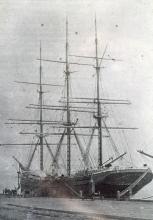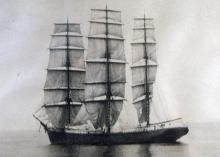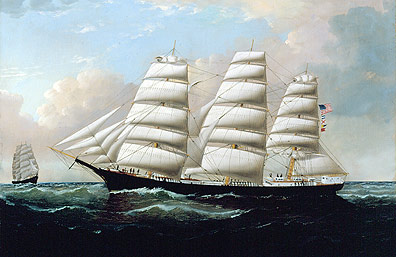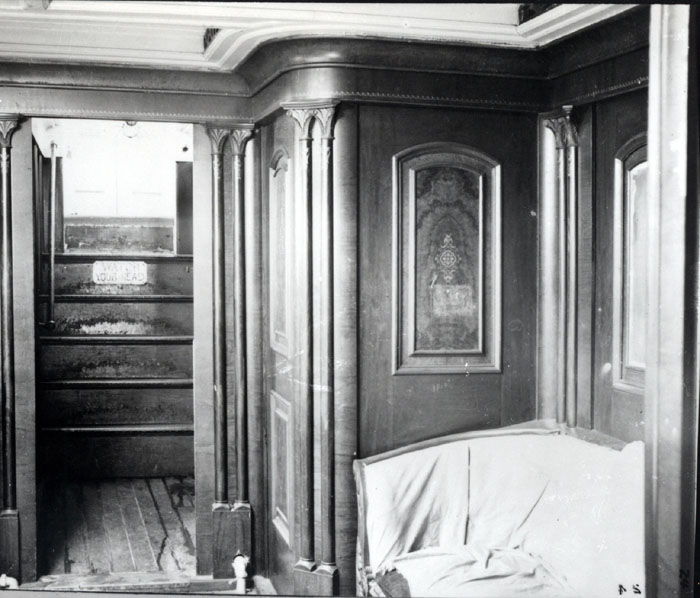Maine's Down Easters
After the Civil War, American shipping went into decline in the face of competition from the British, who led the world in construction of iron steamships and composite iron and wood sailing ships. American economic and political interests shifted from international trade to southern reconstruction, westward expansion, and railroad building.
With skilled labor, plenty of nearby lumber, and low costs, Maine continued building square-riggedSquare-rigged
The arrangement of sails in a vessel where the main driving sails are laced to yards lying square to the mast. It is the oldest type of known rig. Such a vessel is called a square rigger. ships. These competed internationally, carrying low freight-rate cargoes, such as grain, coal, guanoGuano
Droppings of sea birds, with high levels of phosphate and nitrogen making it valuable for fertilzier. Starting in the 1840s centuries of deposits were mined at the Chincha Islands off Peru. Supplies were effectively exhausted in the 1870s; many Maine ships and captains worked the guano trade., iron rails, and keroseneKerosene
A mixture of liquid hydrocarbons obtained by distilling petroleum or shale, and used as a fuel. oil, called case oilCase oil
Kerosene packed in five-gallon cans, two cans to a wooden case.. After the Civil War, California grain exports increased from 43,000 tons in 1865 to 488,000 tons in 1884. American ships carried much of that grain.
Economics determined the design of these deep-sea sailing ships, which came to be called Down EastersDown Easter downeaster; down-easter
Merchant sailing ship developed in Maine in the 19th century and designed for maximum carrying capacity with minimal crew size.
Read more. They were deeper and fuller in shape than the most extreme clipper ships, but they still had clean lines for fast sailing. They were a little bigger than the clippers in volume (register tonnageRegister tonnage tonnage
The carrying capacity of a vessel, a volume measurement now expressed in tons of 100 cubic feet.
Read more), but not in overall length, and carried one and a half times as much cargo. Their three masts carried large sails, but they were easier to handle because the largest sails of the clippers had been split into two smaller sails. The rig was not as extreme as the clipper rig. These changes meant that Down Easters typically required a crew of thirty or forty, half that of a clipper ship. By some counts, Maine built about 350 Down Easters between 1862 and 1902, half built in and around Bath. Penobscot Bay towns built about 55, most during the 1870s. Yet it was the 1880s when Searsport ship captains served as masters on 10% of all U.S. flag square-rigged sailing ships. Local ownership and captaincy of these ships was important to Maine’s supremacy in the Down Easter era. Though the ships never came back to Maine after their launchings, they became an integral part of Maine’s maritime communities. Maine families went to sea and came home, bringing souvenirs and experiences from around the world.
These ships typically sailed out of large ports like New York, Boston, or Philadelphia, and their crews were from all over the world. If a captain came from Maine, one or two mates might also, but the rest of the crew could be from Europe, the West Indies, ChinaChina
During the period of the China Trade, when Mainers were sailing to ports in China, the Qing (or Ch'ing) Dynasty (1644-1911) was in power. The Qing Dynasty was established by the Manchus in northeastern China, and expanded to surrounding territories of Inner Asia, establishing the Empire of the Great Qing.Read more., or other U.S. states.
Down Easters often sailed to California to carry grain to the East Coast or to Liverpool or Hamburg. From England or some East Coast ports, they might carry coal to ports around the world. Ships loading in Philadelphia and New York carried case oil, or illuminating oilIlluminating oil
Kerosene, used in lamps., to San Francisco, China, and Japan. Some carried hempHemp
The plant Cannabis sativa, used to make natural rope. The fibers are usually tarred as a preservative., juteJute
A coarse fiber from one of two East Indian plants, used for making burlap, or mixed with hemp for rope., hidesHides
The thick tough skins of cattle, buffalo, or other large animal., iron rails, sugar, wool, and even guano. Ships going to San Francisco went around Cape HornCape Horn
The southern tip of South America, the main obstacle to sailing west to the Pacific. The wind blows hard from the west, and vessels could take weeks to get around the Cape, into the Pacific Ocean.. If they were going to the Far East, the preferred route was around the Cape of Good HopeCape of Good Hope
The southern tip of Africa. European discovery was by the Portuguese Bartolomeu Dias in 1488. The Dutch East India Company established a base there in 1652 which became a Dutch Colony., taking advantage as much as possible of the prevailing westerliesPrevailing westerlies
Winds that blow from to east between 30 and 60 degrees north and south in both northern and southern hemispheres.Read more. and trade easterliesTrade easterlies
A name for the trade winds which blow from southeast or northeast depending on hemisphere. to make fast passages.
Despite continual competition from British iron sailing and steam ships, Down Easters were not superseded by steam until the early 1900s. Improved engine efficiency cut coal consumption, and opening the Panama CanalPanama Canal
Opened in 1914, the canal connects the Atlantic and Pacific Oceans and is 51 miles long. It crosses the Isthmus of Panama. It was completed by the United States but now belongs to the nation of Panama. shortened steam routes. Few Down Easters were built in the Penobscot Bay area after 1885 and none were built in Maine after 1902. Many Down Easters ended their lives as bargesBarge
The general name given to a flat-bottomed rigged or unrigged craft with a full body and heavy construction. Usually for transportation of bulky freight such as coal, lumber, sand, or stone., or wrecked or otherwise lost at sea. The last one, Benjamin F. Packard, served as an attraction at an amusement park near New York City. Her cabin is preserved at Mystic Seaport Museum.




